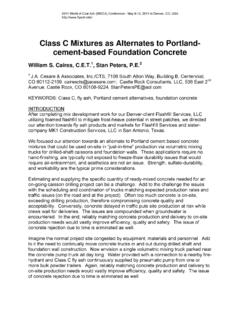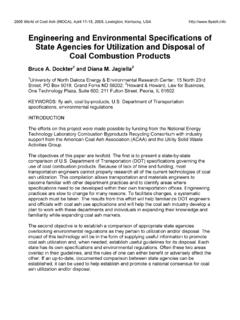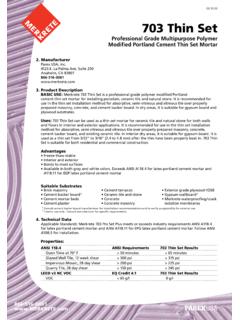Transcription of Portland Cement Dust - Health and Safety Executive
1 Portland Cement dust Hazard assessment document EH75/7 FOREWORD This Hazard Assessment Document has been published by the UK Health and Safety Executive (HSE). It is aimed at a technical audience and reports on the scientific information which underpins the hazard assessment of a specific substance. In Great Britain, substances which cause harm to Health are subject to the Control of Substances Hazardous to Health Regulations (COSHH) 2002 (as amended). The Regulations require employers to prevent or, if that is not reasonably practicable, adequately control employees exposure to hazardous substances. Hazard Assessment Documents are produced to facilitate the development of HSE s regulatory position on a specific Health -related issue, which may relate to an individual hazardous substance, or may involve consideration of more general issues related to chemicals and ill Health .
2 The documents in this series cover issues relating only to toxicological hazards; other document series address issues which involve consideration of occupational exposure and risk: Exposure Assessment Document EH74 series; Risk Assessment Document EH72 series. The data in Hazard Assessment Documents are assessed and endorsed by the Working Group on the Assessment of Toxic Chemicals (WATCH). WATCH makes recommendations to the Advisory Committee on Toxic Substances (ACTS) on all aspects of chemical hazard and risk assessment and risk management issues, including recommendations for occupational exposure limits (OELs) and other aspects of occupational Health risk management, as part of its assessment of the substance under discussion.
3 Hazard Assessment Documents are published after their endorsement by WATCH. 3 Contents Page 1. Summary 6 2. Introduction 7 3. The Health Effects Literature 9 Effects of single exposure 9 Irritation 10 Skin sensitisation 10 Effects of repeated exposure to Cement dust 12 Recent studies of non-malignant respiratory 12 disease in workers with long-term exposure to Cement dust Mortality and cancer studies involving workers 28 with long-term exposure to Cement dust 4. References 46 Table 1 Summary of recent studies of non-malignant respiratory 51 disease in workers with long-term exposure to Cement dust Table 2 Summary of mortality and cancer morbidity studies in 52 Cement manufacturing workers or masons Table 3 Summary of German case control studies for cancers 53 of the oral cavity, pharynx and larynx CI GLOSSARY ATS American Thoracic Society Confidence interval COPD Chronic obstructive lung disease FEF Forced expiratory flow FEV1 Forced expiratory volume in one second FVC Forced vital capacity MRC Medical Research Council (UK)
4 MVV Maximum voluntary ventilation OR Odds ratio PEFR Peak expiratory flow rate RR Relative risk SD Standard deviation of the mean SE Standard error of the mean SIR Standardised incidence ratio SMR Standardised mortality ratio TWA Time weighted average VC Vital capacity WHO World Health Organization 5 1. SUMMARY This hazard assessment updates the Health effects sections of an earlier HSE review of Portland Cement (HSE 1994). The latter is taken to represent an accurate assessment of the literature available up to 1991. This assessment concentrates on the evidence for non-malignant respiratory disease and carcinogenicity. The primary literature on skin sensitisation has not been reviewed because the potential for Cement to cause such reactions, due to the presence of hexavalent chromium, has been established by other reviews.
5 Toxicological endpoints such as reproductive toxicity and mutagenicity have not been considered because there are no data. Concerning non-malignant respiratory disease, HSE (1994) noted evidence that repeated exposure to Portland Cement has produced chronic bronchitis and impaired pulmonary function, but firm conclusions could not be drawn because of limitations of the available studies. The effects of long-term exposure remain poorly studied, particularly because there are no longitudinal prospective studies in workers exposed to Cement . However, many of the 15 recent studies, all conducted outside of the UK, provide evidence of the presence of respiratory problems among Cement factory workers, consistent with the earlier literature.
6 Overall, the pattern of evidence clearly indicates that occupational exposure to Cement dust has produced deficits in respiratory function. However, the evidence available at the present time is insufficient to establish with any confidence the dose-response relationship for these effects. HSE (1994) concluded that there was no convincing evidence for an increased incidence of any site-specific cancer resulting from Cement exposure, but acknowledged that the data available at that time were not consistently and reassuringly negative. Since the early 1990s, a number of relevant cancer cohort and case control studies have been published, conducted in groups exposed to Cement either through employment in Cement factories or in the construction industry.
7 Among these and earlier studies, increased incidences of cancers at several sites (stomach, lungs, colon, pharynx and larynx) were noted, but taking account of limitations in the strength of the observed associations, it is concluded that a causal association between Portland Cement exposure and cancer has not been established. Nevertheless, the findings of the recent studies reviewed in this document maintain the uncertainty concerning a possible risk of cancer raised by the earlier data reviewed by HSE (1994). 6 2. INTRODUCTION This hazard assessment document updates the Health effects sections of an earlier HSE review of Portland Cement (HSE 1994). The latter is taken to represent an accurate assessment of the literature available up to 1991.
8 Consequently this hazard assessment concentrates mainly on literature published after this time, although certain pre-1991 studies are considered in some detail where they help with the interpretation of the recent literature. A copy of the earlier HSE (1994) review is provided as Annex 2 to the WATCH/2005/03. There were two reasons for producing this updating document. Firstly, work related chronic obstructive pulmonary disease (COPD) is a priority within HSE s Occupational Respiratory Disease (ORD) sub-programme. The evidence-base for this sub-programme indicates that occupational exposure to dusts in general leads to an increased risk of COPD. Cement dust is a particularly alkaline and irritant dust , and might therefore be considered to pose a greater risk of respiratory tract damage than many other poorly soluble dusts (generically often referred to as low toxicity dusts ).
9 The HSE (1994) review described evidence for an increased risk of chronic bronchitis and impairment of pulmonary function (consistent with COPD) in Cement dust exposed workers, but there was a lack of data on dose-response relationships. Hence, one reason for undertaking this updating assessment was to see whether the scientific literature on Cement dust published over the last 10 years is now better able to characterise the risks of COPD, and consequently to help determine whether or not Cement dust should be regarded as a particular priority for action within HSE s ORD sub-programme. In addition, it has been drawn to the attention of HSE that in recent years a number of case-control studies have been published suggesting that exposure to Cement dust may be a cause of laryngeal and pharyngeal cancer.
10 It was felt important to examine the evidence from these studies particularly as the earlier HSE review of Portland Cement (HSE 1994) noted that the evidence for carcinogenicity with Cement dust was not reassuringly negative, albeit largely based on concerns for stomach cancer. Given the widespread occupational exposure to Cement dust , it was felt important that HSE develop an updated position in relation to carcinogenicity. Annex 1 provides a detailed explanation of the composition and manufacture of Portland Cement . In brief, Portland Cement is produced by crushing and grinding calcareous materials ( limestone, chalk) and argillaceous materials ( clay, shale), as a wet slurry or in a dry state.














